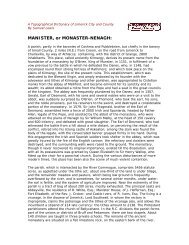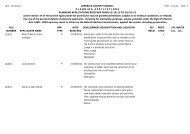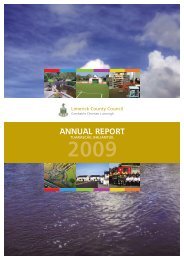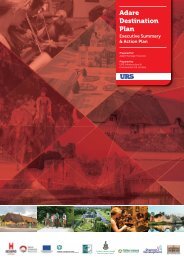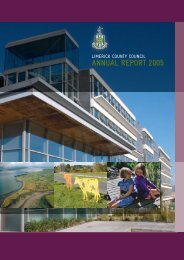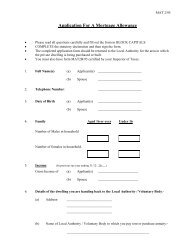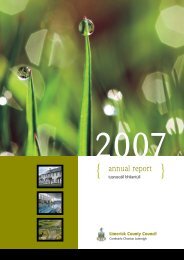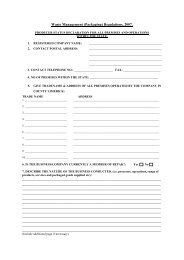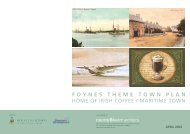Rural Design Advice for Individual Houses in the Countryside
Rural Design Advice for Individual Houses in the Countryside
Rural Design Advice for Individual Houses in the Countryside
You also want an ePaper? Increase the reach of your titles
YUMPU automatically turns print PDFs into web optimized ePapers that Google loves.
DESIGNING THE HOUSE5.Build<strong>in</strong>g ElementsMaterials and ColoursThe traditional build<strong>in</strong>gs of <strong>the</strong> County tend to be verysimple <strong>in</strong> <strong>for</strong>m, with limited decoration, and built of alimited range of locally obta<strong>in</strong>able materials - slate roofs,rendered walls, pa<strong>in</strong>ted timber w<strong>in</strong>dows and doors. Localstone was used <strong>for</strong> construction of walls, but oftenconcealed by whitewash or rough harl render<strong>in</strong>g.Exposed stone construction was reserved <strong>for</strong>outbuild<strong>in</strong>gs associated with <strong>the</strong> ma<strong>in</strong> house. Goodquality ashlar stonework was rarely used <strong>in</strong> vernacularbuild<strong>in</strong>gs, except <strong>for</strong> architectural detail<strong>in</strong>g such asquo<strong>in</strong>s, l<strong>in</strong>tels and chimney stacks, ma<strong>in</strong>ly <strong>in</strong> estatecottages and <strong>in</strong> proximity to quarries. Elsewhere cutstone was reserved <strong>for</strong> important civic build<strong>in</strong>gs(churches, courthouses, schools, etc.) or <strong>for</strong> largecountry mansions.Applied 2-dimensional embellishments, such as artificialcladd<strong>in</strong>g, quo<strong>in</strong>s and columns, should always be avoidedThe colour of a new build<strong>in</strong>g should aim to blend withsurround<strong>in</strong>g build<strong>in</strong>gs and <strong>the</strong> local landscape. Bold,vivid colours should be avoided, especially on walls androofs. Generally <strong>the</strong> use of ‘earthy’ colours thatcomplement <strong>the</strong> natural hues of <strong>the</strong> countryside will bemost appropriate <strong>for</strong> large surfaces (walls). Whites, offwhitesand light greys were often <strong>the</strong> dom<strong>in</strong>ant colours oftraditional build<strong>in</strong>gs, and can effectively off-set morebrightly pa<strong>in</strong>ted elements such as doors. W<strong>in</strong>dows and<strong>the</strong>ir surrounds should preferably also be muted <strong>in</strong>colour.58. 59.57.Simple materials and colours of traditional cottageThe range of contemporary build<strong>in</strong>g materials has<strong>in</strong>creased greatly <strong>in</strong> recent years, provid<strong>in</strong>g newopportunities <strong>for</strong> <strong>the</strong> creative use of natural products.Artificial materials, <strong>in</strong>clud<strong>in</strong>g pvc doors, w<strong>in</strong>dows, eavesand wea<strong>the</strong>rboard<strong>in</strong>g, fibre-cement slates and concreteroof tiles should all be avoided.60.Wherever possible, natural materials that are moresusta<strong>in</strong>able should be used. Timber, glass, slate, plaster,lime mortar, <strong>in</strong>sulation such as sheeps wool, renderedand pa<strong>in</strong>ted blockwork and <strong>the</strong> appropriate use of stonecan be successfully comb<strong>in</strong>ed to create attractivecontemporary houses. Natural materials such as <strong>the</strong>sewill also allow good ventilation <strong>in</strong> <strong>the</strong> home, which hasconsequent health benefits. A random mix of materialssuch as brick, stone and concrete should be avoided.61. 62.63. 64.County Limerick: <strong>Rural</strong> <strong>Design</strong> <strong>Advice</strong> <strong>for</strong> <strong>Individual</strong> <strong>Houses</strong> <strong>in</strong> <strong>the</strong> <strong>Countryside</strong>51.



